Dans l’univers en constante évolution du design de cuisine, les meubles de cuisine vert sauge rustique s’imposent comme un choix remarquable qui apporte chaleur, caractère et charme intemporel au cœur de votre maison. Cette teinte apaisante, inspirée de la nature, trouve le parfait équilibre entre sophistication subtile et charme terreux, devenant ainsi une option de plus en plus populaire pour les propriétaires souhaitant créer des espaces de cuisine accueillants qui sont à la fois frais et authentiques.
Que vous planifiez une rénovation complète ou simplement un rafraîchissement de votre cuisine existante, ce guide complet explorera tout ce que vous devez savoir pour incorporer des meubles vert sauge rustique dans votre espace.


Qu’est-ce que les Meubles de Cuisine Vert Sauge Rustique ?
Les meubles de cuisine vert sauge rustique combinent l’élégance naturelle et tamisée du vert sauge avec des éléments de design rustique qui mettent l’accent sur la texture, la chaleur et une connexion avec la nature. Mais qu’est-ce qui définit exactement le caractère “rustique” des meubles, et pourquoi le vert sauge est-il devenu un choix si apprécié pour ce style ?

Définir l’Esthétique Rustique
L’approche design rustique célèbre les matériaux naturels, les éléments texturés et une apparence légèrement usée et habitée. Appliqué aux meubles de cuisine, le style rustique comprend généralement :
- Le grain du bois visible et les imperfections naturelles
- Des finitions vieillies ou patinées qui suggèrent l’âge et le caractère
- Des poignées simples et directes en matériaux comme le fer forgé, le bronze ou le laiton antique
- Des profils de meuble qui privilégient les styles shaker, lambris ou bois récupéré
- Des éléments artisanaux qui mettent en valeur le savoir-faire plutôt que la perfection

Comprendre le Vert Sauge comme Couleur de Meuble
Le vert sauge est une nuance de vert grisâtre et tamisée, inspirée de la plante du même nom. Il présente :
- Des sous-tons terreux qui se connectent aux éléments naturels
- Une qualité douce et désaturée qui est à la fois apaisante et sophistiquée
- Suffisamment de couleur pour faire une déclaration sans submerger l’espace
- Une polyvalence qui fonctionne avec plusieurs styles de design au-delà du rustique
- Une qualité intemporelle qui ne se démode pas comme les couleurs plus tendance
Combinés, le style rustique et le vert sauge créent des meubles de cuisine qui incarnent l’élégance naturelle tout en fournissant un arrière-plan parfait pour la vie quotidienne et les rassemblements spéciaux.

Pourquoi Choisir des Meubles de Cuisine Vert Sauge Rustique ?
La popularité croissante des meubles de cuisine vert sauge rustique n’est pas simplement une tendance passagère. Il existe des raisons convaincantes pour lesquelles cette combinaison résonne auprès de tant de propriétaires et de designers.
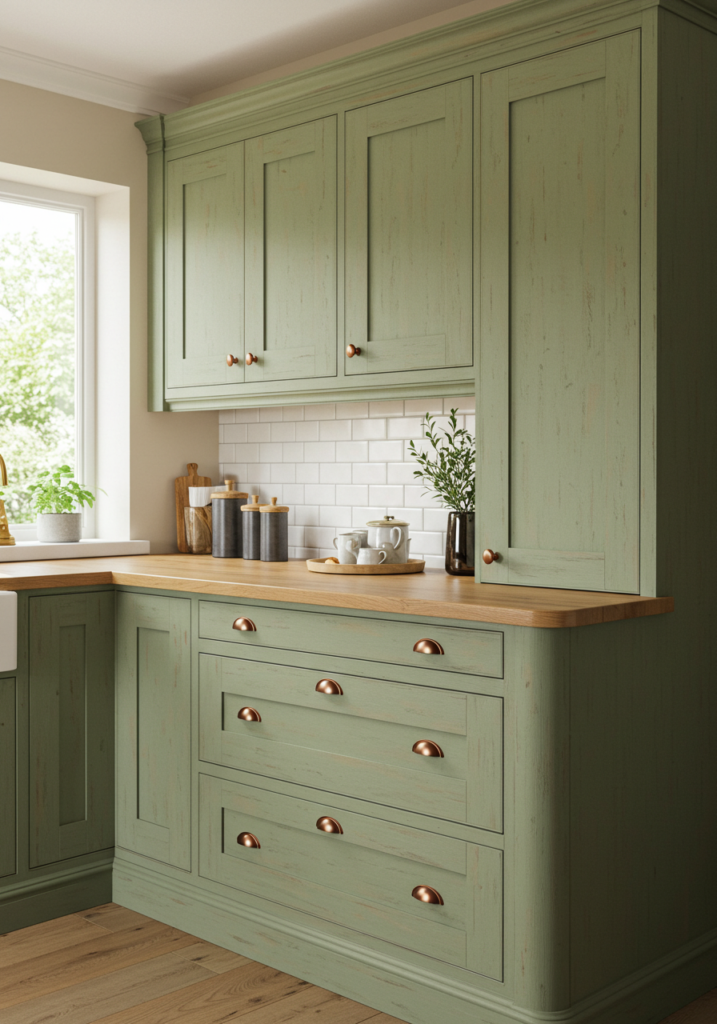
L’Attrait Visuel du Vert Sauge dans les Cuisines
Les cuisines vert sauge offrent une alternative rafraîchissante aux couleurs de meubles plus communes tout en offrant de nombreux avantages esthétiques :
- Création d’une atmosphère apaisante qui rend la cuisine accueillante
- Fonction de neutre polyvalent qui se coordonne avec de nombreuses palettes de couleurs
- Connexion des espaces intérieurs avec les environnements extérieurs
- Apport de couleur subtile sans l’intensité des nuances vertes plus vives
- Belle évolution tout au long de la journée avec les variations de lumière naturelle

Les Avantages Pratiques des Finitions Rustiques
Au-delà de la pure esthétique, les finitions rustiques offrent des avantages pratiques pour les cuisines très fréquentées :
- Dissimulation des usures mineures mieux que les finitions modernes et lisses
- Développement du caractère avec le temps plutôt que simple apparence d’usure
- Facilité des retouches en cas de dommage
- Création d’un arrière-plan indulgent pour l’inévitable désordre de la cuisine
- Maintien de son attrait à travers les tendances changeantes du design
Connexion Émotionnelle et Design Biophilique
La combinaison du vert sauge et des éléments rustiques s’inscrit dans les principes du design biophilique—notre connexion innée à la nature :
- Les tons verts ont démontré leur capacité à réduire le stress et promouvoir le bien-être
- Les matériaux naturels et les textures créent une richesse sensorielle
- L’approche rustique met l’accent sur la durabilité et la longévité plutôt que sur un design jetable
- Création d’espaces à la fois ancrés et inspirants


Comment Styliser une Cuisine avec des Meubles Vert Sauge Rustique
Créer un design de cuisine cohérent autour des meubles vert sauge rustique nécessite une réflexion sur les éléments complémentaires. Voici comment donner vie à votre vision avec succès.
Associations de Plans de Travail qui Valorisent le Vert Sauge
Le bon plan de travail crée une harmonie avec les meubles vert sauge rustique :
- Les plans de travail en bloc de boucher ou en bois récupéré amplifient l’ambiance rustique tout en ajoutant de la chaleur
- La pierre ollaire offre un contraste dramatique avec sa couleur charbon profond et ses veines naturelles
- Le quartz blanc crée un contraste net qui met en valeur les meubles vert sauge
- Les plans de travail en béton aux tons gris naturels complètent la qualité terreuse du sauge
- Le marbre adouci avec des veines subtiles ajoute de l’élégance tout en maintenant l’esthétique naturelle

Idées de Dosseret pour les Cuisines Rustiques Vert Sauge
Votre dosseret peut soit compléter soit contraster avec vos meubles :
- Les carreaux de métro blancs créent un contraste classique qui éclaire l’espace
- Les carreaux de céramique faits main avec de légères irrégularités renforcent l’aspect rustique
- Les dosserets en pierre naturelle dans des tons crème ou beige ajoutent un intérêt textural
- Le parement de briques apporte un caractère rustique supplémentaire et de la chaleur
- Les dosserets en lambris peints en blanc créent un charme cottage avec les meubles vert sauge

Options de Revêtement de Sol qui Ancrent le Design
Le bon revêtement de sol ancre votre cuisine vert sauge rustique :
- Plancher en bois à larges lames dans des tons moyens à clairs
- Carreaux en terre cuite ou argile naturelle pour des cuisines rustiques d’inspiration méditerranéenne
- Carreaux de sol en ardoise grise ou gris-bleu ajoutent une rusticité sophistiquée
- Sols en bois récupéré avec des marques de caractère visibles et une patine
- Revêtement de sol en vinyle de luxe avec motifs de bois pour un attrait rustique pratique
Quelles Couleurs se Marient avec les Meubles de Cuisine Vert Sauge ?
Créer un schéma de couleurs cohérent met en valeur la beauté de vos meubles vert sauge rustique. Voici des combinaisons de couleurs gagnantes à considérer.
Couleurs Murales Complémentaires
La bonne couleur murale peut faire briller vos meubles vert sauge :
- Les blancs chauds comme le blanc cassé ou la crème créent un contraste doux
- Les murs gris pâle offrent une neutralité sophistiquée
- Les tons terracotta doux ou argile ajoutent de la chaleur et un contraste terreux
- Les murs beige clair ou grège offrent une harmonie subtile
- Une nuance plus profonde de vert sauge pour un look monochromatique avec dimension
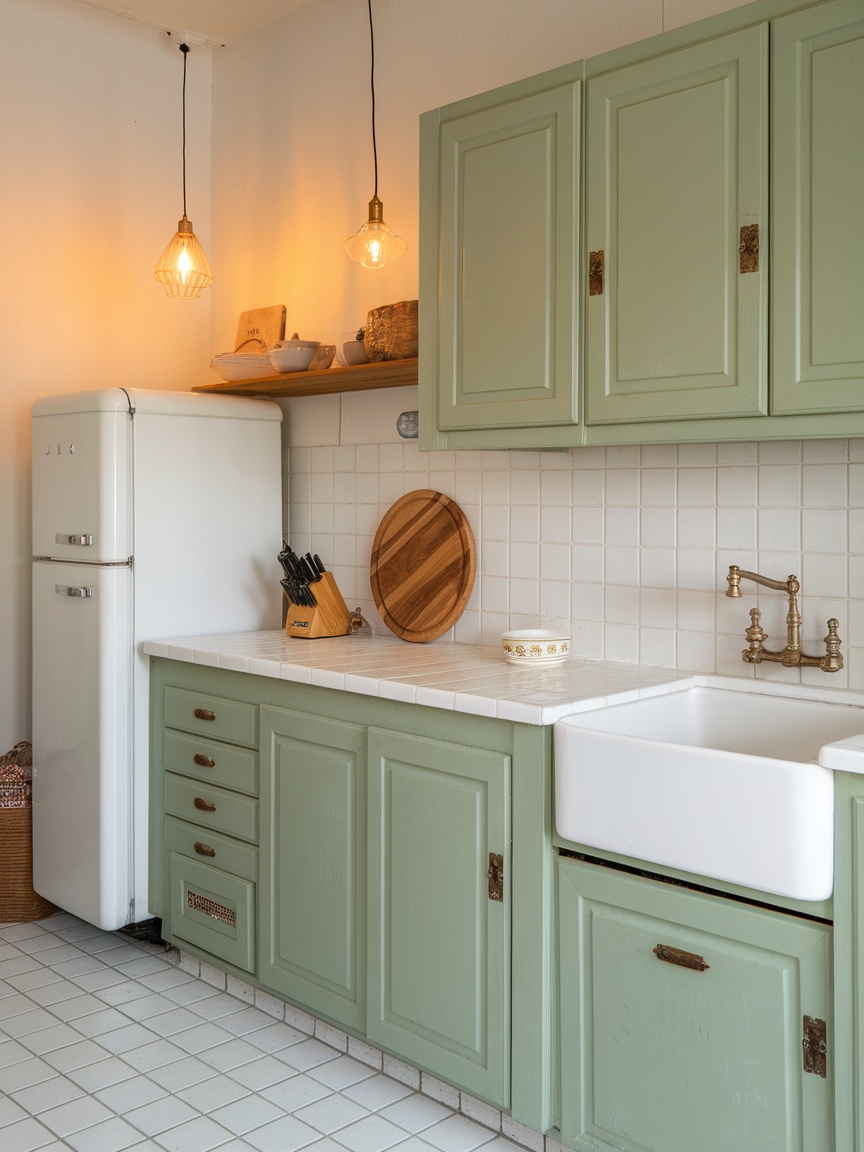
Couleurs d’Accent qui Valorisent le Vert Sauge
Des couleurs d’accent stratégiques ajoutent de la personnalité à votre cuisine rustique vert sauge :
- Bleu marine ou indigo tamisé pour un contraste classique
- Terracotta ou orange brûlé pour des accents chauds et terreux
- Jaune moutarde pour des touches de couleur surprenantes
- Noir ou anthracite pour des éléments d’ancrage
- Tons bois naturels pour renforcer la qualité rustique
Considérations sur les Finitions Métalliques et la Quincaillerie
Votre choix de quincaillerie et accessoires impacte significativement l’aspect final :
- La quincaillerie en laiton antique ajoute de la chaleur et du caractère vieilli
- Le bronze huilé crée un contraste dramatique avec le sauge
- La quincaillerie et les accessoires en fer forgé soulignent l’authenticité rustique
- Le nickel brossé offre une approche plus contemporaine du sauge rustique
- Les accents en cuivre ajoutent de la chaleur et développent une patine vivante avec le temps
Les Murs de Cuisine Vert Sauge sont-ils une Bonne Idée ?
Les murs de cuisine vert sauge créent un effet différent des meubles vert sauge. Voici ce qu’il faut considérer avant de peindre les murs de votre cuisine dans cette couleur polyvalente.
Quand les Murs Sauge Fonctionnent le Mieux
Les murs de cuisine vert sauge peuvent être magnifiques dans les bonnes circonstances :
- Dans les cuisines avec des meubles blancs, crème ou en bois nécessitant une touche de couleur
- Quand vous voulez tester la vie avec le sauge avant de vous engager pour des meubles
- Dans les espaces à concept ouvert où la couleur aide à définir la zone cuisine
- Quand vous recherchez une atmosphère paisible sans rénovations majeures
- Dans les petites cuisines où peindre les meubles pourrait sembler écrasant
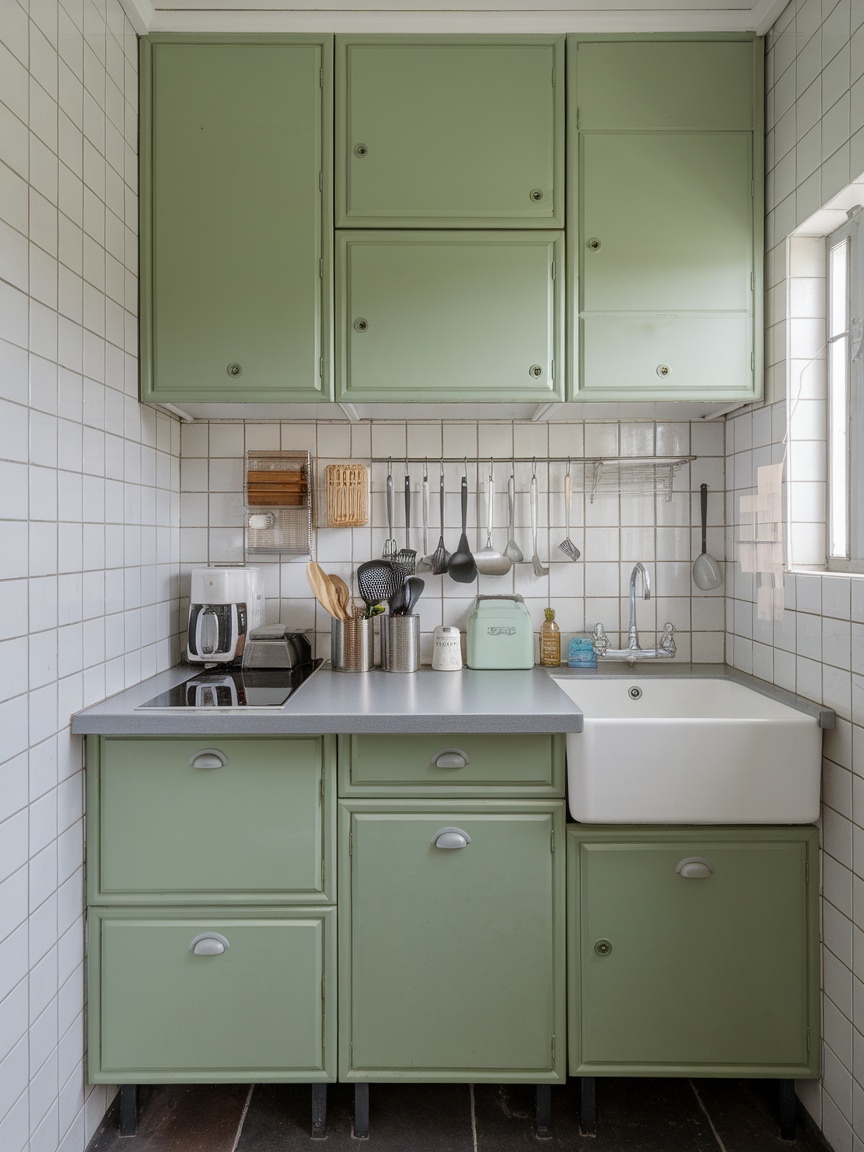
Combiner des Murs Sauge avec Différentes Couleurs de Meubles
Différentes couleurs de meubles créent des looks distincts lorsqu’elles sont associées à des murs sauge :
- Les meubles blancs créent un look frais et propre contre des murs sauge
- Les meubles noirs offrent un contraste dramatique pour une approche rustique plus moderne
- Les meubles en bois naturel apportent de la chaleur et renforcent la connexion à la nature
- Les meubles gris créent un look sophistiqué et tonal avec des murs sauge
- Les meubles bleu marine offrent un contraste inattendu dans un schéma de couleurs complémentaires
Approches Alternatives aux Murs Sauge Complets
Si des murs entièrement sauge semblent trop, considérez ces alternatives :
- Des murs de cuisine vert sauge comme mur d’accent derrière la cuisinière
- Approche bicolore avec du sauge en bas et de la crème au-dessus
- Carreaux de dosseret vert sauge comme élément de couleur ciblé
- Boiseries de fenêtre vert sauge contre des murs blancs
- Plafond vert sauge pour un placement de couleur inattendu

Comment Incorporer un Îlot de Cuisine Vert Sauge
Un îlot de cuisine vert sauge offre une alternative à l’engagement total pour des meubles sauge. Voici comment faire de ce point focal un élément magnifique dans votre cuisine.
Avantages d’un Îlot de Cuisine Vert Sauge
Un îlot vert sauge sert plusieurs objectifs de design :
- Création d’un point focal dans les cuisines avec des meubles périphériques neutres
- Ajout de couleur sans submerger tout l’espace
- Permet de tester le vert sauge avant de s’engager pour tous les meubles
- Crée une séparation naturelle dans les cuisines à concept ouvert
- Ancre l’espace avec une présence apaisante et substantielle
Idées de Design pour les Îlots Rustiques Sauge
Renforcez la qualité rustique de votre îlot sauge avec ces éléments :
- Dessus d’îlot en bloc de boucher ou bois récupéré
- Détails en lambris ou bardage sur les côtés de l’îlot
- Étagères ouvertes incorporées dans la structure de l’îlot
- Pieds tournés ou détails style mobilier
- Suspensions d’inspiration vintage au-dessus
Créer un Contraste Entre l’Îlot et le Périmètre
Différentes approches pour créer une distinction entre votre îlot sauge et les meubles environnants :
- Meubles périphériques blancs ou crème pour un contraste classique
- Meubles périphériques en bois naturel pour chaleur et texture
- Meubles périphériques noirs ou gris foncé pour un effet dramatique
- Même couleur sauge mais styles de meubles différents pour une distinction subtile
- Matériaux de plan de travail contrastants entre l’îlot et le périmètre
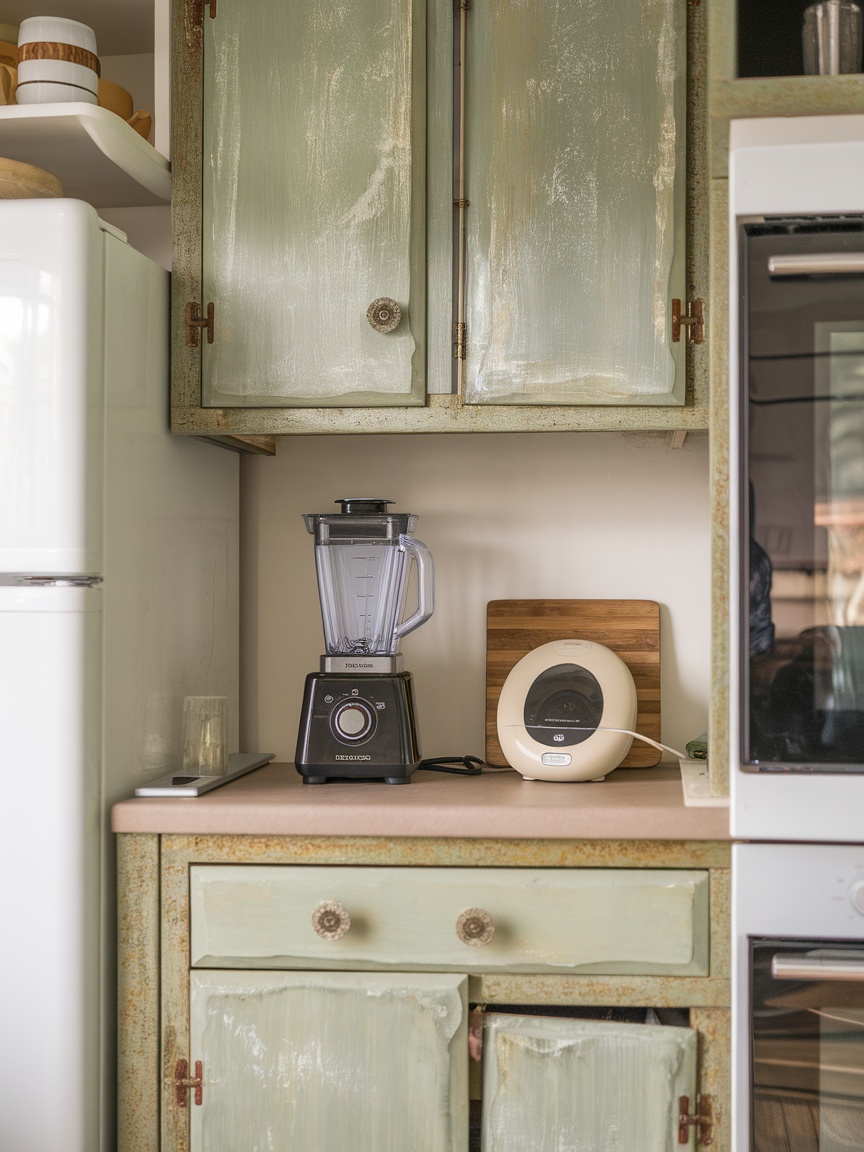
Quelle est la Différence Entre les Meubles de Cuisine Vert Sauge Rustique et Campagnard ?
Bien que les styles rustique et campagnard partagent des similitudes, ils ont des caractéristiques distinctes qui créent des esthétiques différentes lorsqu’appliqués aux meubles de cuisine vert sauge.
Définir les Meubles de Cuisine Vert Sauge Campagnard
Les meubles de cuisine vert sauge campagnard présentent généralement :
- Des lignes plus propres et moins de vieillissement que les styles fortement rustiques
- Plus d’accents blancs et noirs pour le contraste
- Des éviers à tablier (campagnard) comme élément signature
- Des matériaux mixtes incluant bois peint et naturel
- Des touches industrielles comme des luminaires et quincaillerie métalliques
- Plus d’emphase sur les détails d’inspiration vintage
Caractéristiques des Meubles Vert Sauge Rustique
Les véritables meubles vert sauge rustique incorporent généralement :
- Plus de texture visible et de vieillissement
- Plus grande emphase sur les matériaux naturels
- Moins de contraste et plus de profondeur tonale
- Moins d’éléments industriels
- Plus de qualités organiques, imparfaites
- Apparences plus patinées que délibérément vieillies
Approches Transitionnelles Entre les Styles
De nombreux propriétaires préfèrent un mélange d’éléments rustiques et campagnards :
- Meubles vert sauge style shaker avec vieillissement modéré
- Mélange d’étagères ouvertes et de meubles fermés
- Combinaison d’accents métalliques et en bois naturel
- Quincaillerie noire contre sauge pour un contraste campagnard avec des styles de porte rustiques
- Incorporation d’éléments vintage avec des caractéristiques contemporaines plus épurées

Idées pour Petites Cuisines avec Meubles Vert Sauge Rustique
Les cuisines plus petites peuvent magnifiquement mettre en valeur les meubles vert sauge rustique avec quelques adaptations réfléchies.
Faire Fonctionner le Sauge dans des Espaces Limités
Approches stratégiques pour les petites cuisines vert sauge :
- Considérer des meubles hauts dans une couleur plus claire avec des bas sauge pour plus de légèreté
- Incorporer des portes de meuble vitrées pour créer de la profondeur
- Utiliser la même couleur sur les murs et les meubles pour une expansion d’espace homogène
- Concentrer le vert sauge sur un mur d’armoires statement
- Choisir des nuances de sauge légèrement plus claires qui n’absorberont pas trop de lumière
Solutions Maximisant l’Espace
Éléments fonctionnels qui améliorent les petites cuisines rustiques vert sauge :
- Étagères ouvertes à la place de certains meubles hauts
- Rangement de garde-manger coulissant pour une efficacité maximale
- Îlot ou péninsule avec base sauge et comptoir en surplomb pour des sièges
- Quincaillerie à profil plus mince qui ne dépassera pas trop
- Éclairage sous les meubles pour éclairer l’espace de travail
Créer une Expansion Visuelle
Astuces de design qui font paraître les petites cuisines sauge plus grandes :
- Revêtement de sol continu qui s’écoule sans interruption dans les espaces adjacents
- Détails de bardage vertical ou lambris qui attirent l’œil vers le haut
- Minimiser les meubles hauts sur un mur pour créer de l’ouverture
- Utiliser des plans de travail plus clairs pour refléter plus de lumière
- Miroirs ou carreaux de dosseret réfléchissants pour amplifier la lumière

Conseils d’Entretien pour les Meubles Vert Sauge Rustique
Maintenir la beauté de vos meubles de cuisine vert sauge rustique nécessite quelques considérations d’entretien spécifiques.
Recommandations de Nettoyage
Un nettoyage approprié préserve la finition et l’apparence :
- Utiliser des nettoyants doux, non abrasifs sans produits chimiques agressifs
- Nettoyer rapidement les éclaboussures pour éviter les taches sur les surfaces peintes
- Dépoussiérer régulièrement avec un chiffon microfibre doux
- Appliquer des nettoyants pour meubles spécifiquement formulés pour le bois peint
- Considérer l’application occasionnelle de revitalisant pour bois pour les éléments en bois exposés
Stratégies de Retouche
Quand l’usure survient inévitablement :
- Garder de la peinture supplémentaire pour les retouches (vert sauge et tout glacis utilisé)
- Utiliser des pinceaux d’artiste pour des retouches précises sur les petits éclats
- Considérer la cire à meuble transparente pour protéger les zones vieillies
- Documenter vos couleurs et finitions exactes pour référence future
- Maintenir des routines de nettoyage constantes pour éviter l’usure inégale
Quand Rafraîchir vs Remplacer
Lignes directrices pour l’entretien des meubles à long terme :
- Les portes d’armoire montrent typiquement l’usure en premier et peuvent être repeintes sans remplacement
- La quincaillerie peut être mise à jour pour un look frais sans changer les meubles
- Une remise à neuf professionnelle peut prolonger la vie des meubles de 5-10 ans
- Les meubles de qualité avec construction en bois massif valent la peine d’être refacés plutôt que remplacés
- Considérer peindre les meubles existants en vert sauge au lieu d’un remplacement complet pour des mises à jour économiques
DIY vs Installation Professionnelle de Meubles Vert Sauge
Que vous fassiez vous-même vos meubles de cuisine vert sauge ou engagiez des professionnels dépend de plusieurs facteurs.
Quand le DIY Est Logique
Considérez la voie DIY quand :
- Vous repeignez des meubles existants plutôt que d’en installer de nouveaux
- Vous avez de l’expérience avec la restauration ou la peinture de meubles
- Vous voulez créer une finition rustique véritablement artisanale et authentique
- Les contraintes budgétaires rendent la peinture professionnelle prohibitive
- Vous avez suffisamment de temps à consacrer à une préparation et une exécution appropriées

Avantages Professionnels
L’installation ou la peinture professionnelle offre ces avantages :
- Les meubles finis en usine fournissent la finition la plus durable
- L’application professionnelle au pistolet crée les résultats les plus lisses
- Les experts peuvent créer un vieillissement et un glacis cohérents
- Les garanties accompagnent généralement l’installation professionnelle
- Les économies de temps peuvent compenser le coût supplémentaire
Approches Hybrides
Considérez ces options intermédiaires :
- Acheter des meubles non finis et réaliser vous-même la finition vert sauge
- Engager des professionnels pour l’installation mais faire vous-même la finition
- Faire appliquer la couche de base par des professionnels mais faire vous-même le vieillissement et le glacis
- Faire vous-même les meubles du périmètre mais acheter un îlot de cuisine pré-fini vert sauge
- Utiliser de la peinture à la craie pour une application DIY plus facile avec des résultats rustiques

Conclusion : L’Attrait Intemporel des Cuisines Vert Sauge Rustique
Les meubles de cuisine vert sauge rustique offrent un beau mélange de couleur inspirée par la nature et de chaleur texturée qui créent des espaces de cuisine et de rassemblement véritablement accueillants. Contrairement aux choix de couleurs plus tendance, le vert sauge a prouvé sa pérennité, évoluant des cuisines campagnardes classiques aux espaces farmhouse contemporains et aux designs rustiques modernes.
La polyvalence du vert sauge le rend adaptable à diverses approches de design, que vous créiez une retraite entièrement rustique, un centre familial d’inspiration farmhouse, ou un espace transitionnel qui fait le pont entre les éléments traditionnels et contemporains. En combinant judicieusement les meubles vert sauge avec des couleurs, matériaux et éléments de design complémentaires, vous pouvez créer une cuisine qui semble à la fois personnellement expressive et intemporellement attrayante.
Que vous planifiez une rénovation complète de cuisine ou cherchiez des moyens de rafraîchir votre espace existant, les meubles vert sauge rustique offrent une base apaisante et sophistiquée qui connecte votre maison à la nature tout en créant un environnement pratique et accueillant pour cuisiner, se rassembler et créer des souvenirs.





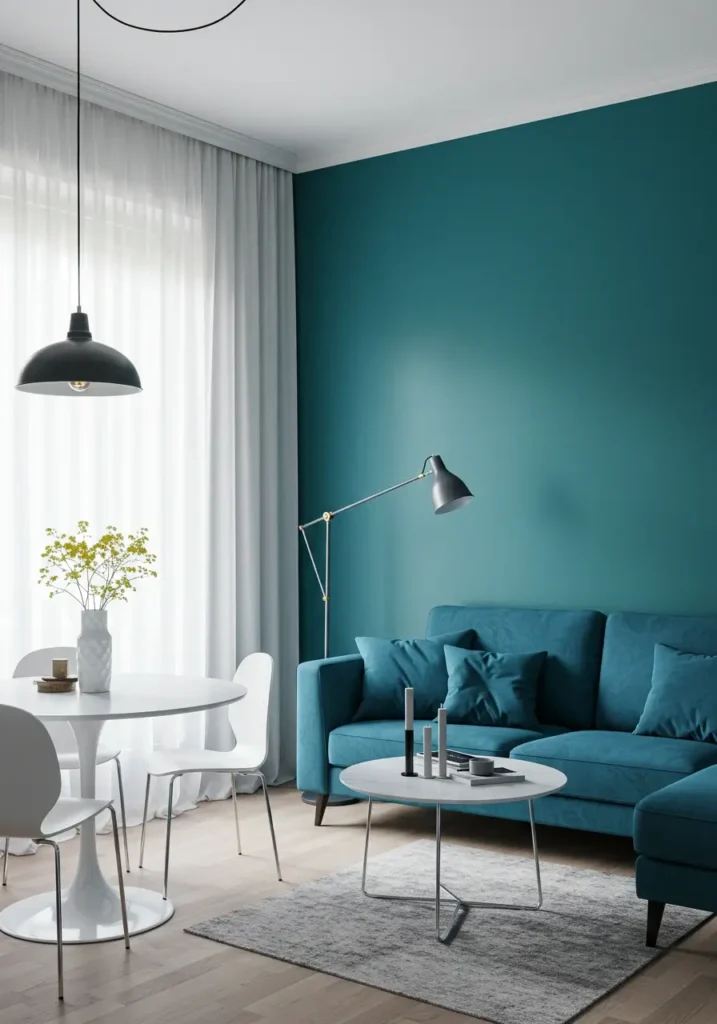

Pingback: Basement Ideas: The Ultimate Guide to Transform Your Space in 2025 -